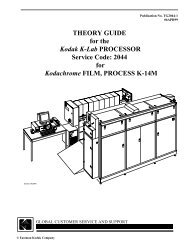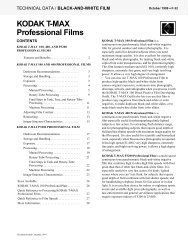Using KODAK EKTACOLOR PRIME SP Chemicals in DKS ... - 125px
Using KODAK EKTACOLOR PRIME SP Chemicals in DKS ... - 125px
Using KODAK EKTACOLOR PRIME SP Chemicals in DKS ... - 125px
Create successful ePaper yourself
Turn your PDF publications into a flip-book with our unique Google optimized e-Paper software.
Developer Fresh Tank Solution<br />
To ensure good performance, take special care <strong>in</strong> mix<strong>in</strong>g<br />
the developer tank solution.<br />
Table 8 Prepar<strong>in</strong>g Developer Tank Solution from<br />
<strong>KODAK</strong> <strong>EKTACOLOR</strong> <strong>PRIME</strong> <strong>SP</strong> Developer<br />
Replenisher LORR Concentrate<br />
From <strong>KODAK</strong> <strong>EKTACOLOR</strong><br />
<strong>PRIME</strong> <strong>SP</strong> Developer LORR<br />
Concentrate<br />
Volume<br />
Add water to developer tank 7.98 L<br />
Add <strong>PRIME</strong> <strong>SP</strong> Developer LORR<br />
concentrate,<br />
Add <strong>EKTACOLOR</strong> RA Developer<br />
Starter (see page 4b for CAT No.)<br />
800mL<br />
220 mL<br />
Total volume of Developer tank 9.0 L<br />
Re<strong>in</strong>stall<strong>in</strong>g the Racks and Br<strong>in</strong>g<strong>in</strong>g the<br />
Tank Solutions to Temperature<br />
The tanks will appear only partially filled after you have<br />
added the solutions. When you re<strong>in</strong>stall the racks <strong>in</strong> the<br />
tanks, the racks will displace more solution volume to fill<br />
the tanks.<br />
Install the racks by slowly lower<strong>in</strong>g them <strong>in</strong>to the<br />
tanks. When you have re<strong>in</strong>stalled all the racks and have<br />
verified that all the tanks are filled with solution, turn on<br />
the recirculation and heater system and br<strong>in</strong>g the<br />
solutions up to operat<strong>in</strong>g temperature.<br />
USING CONTROL STRIPS TO MONITOR THE<br />
PROCESS<br />
Use <strong>KODAK</strong> Control Strips, Process RA-4 (box of 50,<br />
CAT No. 828 2170, or box of 25, CAT 898 2746), to<br />
monitor process performance. For <strong>in</strong>structions on<br />
process<strong>in</strong>g control strips, see the operator’s manual for<br />
the <strong>DKS</strong> M<strong>in</strong>ilab. For <strong>in</strong>formation on the use and<br />
diagnostic features of the control strips, see <strong>KODAK</strong><br />
Publication No. Z-130, <strong>Us<strong>in</strong>g</strong> <strong>KODAK</strong> <strong>EKTACOLOR</strong><br />
<strong>Chemicals</strong>, Section 7, “Process Monitor<strong>in</strong>g and<br />
Troubleshoot<strong>in</strong>g with <strong>KODAK</strong> Control Strips, Process<br />
RA-4.” <strong>KODAK</strong> Publications are available on our<br />
website at www.Kodak.com/go/photochemicals.<br />
To calculate control-strip aim values for process<br />
monitor<strong>in</strong>g, you will need to apply process adjustment<br />
factors. Use the adjustment factors <strong>in</strong> addition to the<br />
correction factors that are supplied with the control strips.<br />
After read<strong>in</strong>g the densities of the supplied reference<br />
strip on your densitometer, first apply the correction<br />
factors packaged with the reference strip. Then add the<br />
values from the follow<strong>in</strong>g table. The corrected density<br />
values are the aim values for your batch of control strips.<br />
You will need to apply the adjustment factors each time<br />
you switch to a new batch of control strips.<br />
Table 8 Process Adjustment Factors<br />
Measurement R G B<br />
Black (BP) -0.03 -0.01 -0.07<br />
High (HD) -0.06 +0.03 -0.13<br />
Low (LD) -0.05 +0.05 -0.08<br />
D-m<strong>in</strong> +0.01 +0.01 +0.01<br />
SILVER RECOVERY<br />
The comb<strong>in</strong>ed overflows from the bleach-fix and<br />
stabilizer tanks are collected <strong>in</strong> separate effluent tanks <strong>in</strong><br />
the <strong>DKS</strong> Digital (20 sec) Series M<strong>in</strong>ilab. When an<br />
effluent tank is full, the processor alerts you to dra<strong>in</strong> the<br />
tank.<br />
Typically, silver concentration <strong>in</strong> the bleach-fix<br />
effluent tank will be 4 to 8 g/L; silver concentration <strong>in</strong> the<br />
stabilizer effluent tank will be 0.2 to 0.6 g/L.<br />
You can effectively use common silver-recovery<br />
methods with the comb<strong>in</strong>ed effluents from both effluent<br />
tanks. If your lab has other processors, you can comb<strong>in</strong>e<br />
the effluent from the <strong>DKS</strong> Digital M<strong>in</strong>ilabs with the other<br />
effluent solutions and use your current silver-recovery<br />
methods.<br />
Publications on silver management that <strong>in</strong>clude<br />
recommendations and descriptions of silver-recovery<br />
options are available <strong>in</strong> the Silver Management section of<br />
the Kodak Environmental Services Publications Center at<br />
www.Kodak.com/go/KES.<br />
<strong>Us<strong>in</strong>g</strong> <strong>KODAK</strong> <strong>EKTACOLOR</strong> <strong>PRIME</strong> <strong>SP</strong> <strong>Chemicals</strong> <strong>in</strong> <strong>DKS</strong> Digital M<strong>in</strong>ilabs with a 20-Second Cycle CIS-278E 5

















